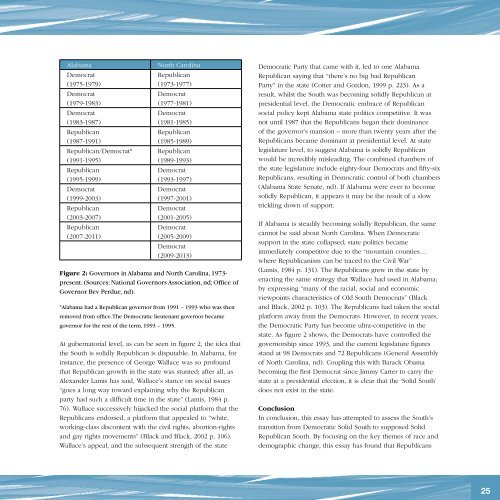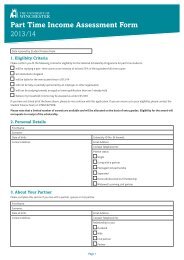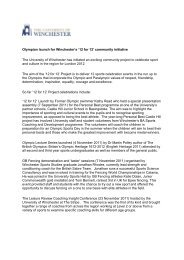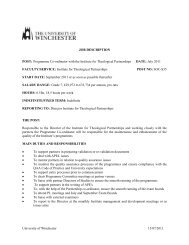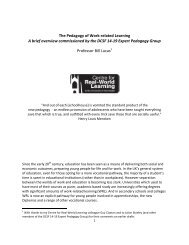alfred 2 - University of Winchester
alfred 2 - University of Winchester
alfred 2 - University of Winchester
You also want an ePaper? Increase the reach of your titles
YUMPU automatically turns print PDFs into web optimized ePapers that Google loves.
Alabama North Carolina<br />
Democrat<br />
(1975-1979)<br />
Democrat<br />
(1979-1983)<br />
Democrat<br />
(1983-1987)<br />
Republican<br />
(1987-1991)<br />
Republican/Democrat*<br />
(1991-1995)<br />
Republican<br />
(1995-1999)<br />
Democrat<br />
(1999-2003)<br />
Republican<br />
(2003-2007)<br />
Republican<br />
(2007-2011)<br />
Republican<br />
(1973-1977)<br />
Democrat<br />
(1977-1981)<br />
Democrat<br />
(1981-1985)<br />
Republican<br />
(1985-1989)<br />
Republican<br />
(1989-1993)<br />
Democrat<br />
(1993-1997)<br />
Democrat<br />
(1997-2001)<br />
Democrat<br />
(2001-2005)<br />
Democrat<br />
(2005-2009)<br />
Democrat<br />
(2009-2013)<br />
Figure 2: Governors in Alabama and North Carolina, 1973-<br />
present. (Sources: National Governors Association, nd; Office <strong>of</strong><br />
Governor Bev Perdue, nd).<br />
*Alabama had a Republican governor from 1991 – 1993 who was then<br />
removed from <strong>of</strong>fice. The Democratic lieutenant governor became<br />
governor for the rest <strong>of</strong> the term, 1993 – 1995.<br />
At gubernatorial level, as can be seen in figure 2, the idea that<br />
the South is solidly Republican is disputable. In Alabama, for<br />
instance, the presence <strong>of</strong> George Wallace was so pr<strong>of</strong>ound<br />
that Republican growth in the state was stunted; after all, as<br />
Alexander Lamis has said, Wallace’s stance on social issues<br />
“goes a long way toward explaining why the Republican<br />
party had such a difficult time in the state” (Lamis, 1984 p.<br />
76). Wallace successively hijacked the social platform that the<br />
Republicans endorsed, a platform that appealed to “white,<br />
working-class discontent with the civil rights, abortion-rights<br />
and gay rights movements” (Black and Black, 2002 p. 106).<br />
Wallace’s appeal, and the subsequent strength <strong>of</strong> the state<br />
Democratic Party that came with it, led to one Alabama<br />
Republican saying that “there’s no big bad Republican<br />
Party” in the state (Cotter and Gordon, 1999 p. 223). As a<br />
result, whilst the South was becoming solidly Republican at<br />
presidential level, the Democratic embrace <strong>of</strong> Republican<br />
social policy kept Alabama state politics competitive. It was<br />
not until 1987 that the Republicans began their dominance<br />
<strong>of</strong> the governor’s mansion – more than twenty years after the<br />
Republicans became dominant at presidential level. At state<br />
legislature level, to suggest Alabama is solidly Republican<br />
would be incredibly misleading. The combined chambers <strong>of</strong><br />
the state legislature include eighty-four Democrats and fifty-six<br />
Republicans, resulting in Democratic control <strong>of</strong> both chambers<br />
(Alabama State Senate, nd). If Alabama were ever to become<br />
solidly Republican, it appears it may be the result <strong>of</strong> a slow<br />
trickling down <strong>of</strong> support.<br />
If Alabama is steadily becoming solidly Republican, the same<br />
cannot be said about North Carolina. When Democratic<br />
support in the state collapsed, state politics became<br />
immediately competitive due to the “mountain counties…<br />
where Republicanism can be traced to the Civil War”<br />
(Lamis, 1984 p. 131). The Republicans grew in the state by<br />
enacting the same strategy that Wallace had used in Alabama;<br />
by expressing “many <strong>of</strong> the racial, social and economic<br />
viewpoints characteristics <strong>of</strong> Old South Democrats” (Black<br />
and Black, 2002 p. 103). The Republicans had taken the social<br />
platform away from the Democrats. However, in recent years,<br />
the Democratic Party has become ultra-competitive in the<br />
state. As figure 2 shows, the Democrats have controlled the<br />
governorship since 1993, and the current legislature figures<br />
stand at 98 Democrats and 72 Republicans (General Assembly<br />
<strong>of</strong> North Carolina, nd). Coupling this with Barack Obama<br />
becoming the first Democrat since Jimmy Carter to carry the<br />
state at a presidential election, it is clear that the ‘Solid South’<br />
does not exist in the state.<br />
Conclusion<br />
In conclusion, this essay has attempted to assess the South’s<br />
transition from Democratic Solid South to supposed Solid<br />
Republican South. By focusing on the key themes <strong>of</strong> race and<br />
demographic change, this essay has found that Republicans<br />
25


